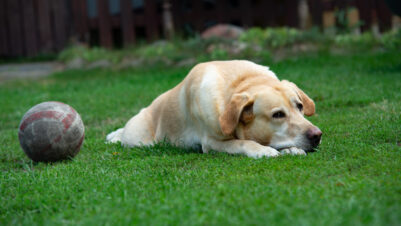
Seeing our dogs age is saddening and emotionally draining. Improving the physical and mental welfare of our older dogs by making as many adaptations as we can not only helps the dog, but can improve the owner’s enjoyment of their dog’s final years. In January 2020 I said “goodbye” to my own 14-year-old dog, Denzel. In the last few years of his life, I made the following observations and adaptations that undoubtedly improved his quality of life.
Pain relief
Routine pain relief can significantly improve an older dog’s life, especially if they have osteoarthritis or other degenerative skeletal or muscular conditions. For some owners, it is perhaps too easy to overlook subtle signs of pain, discomfort and general stiffness in older dogs. This may lead to delayed presentation to veterinarians (Belshaw et al., 2020).
Whilst risk of side effects associated with analgesia may be of concern to owners and veterinarians (Belshaw et al., 2016), a dog’s daily quality of life needs to be taken into consideration. Routine pain relief for older dogs may give renewed enthusiasm for exercise and make it easier to jump in and out of the car, as well as on and off the sofa or up and down the stairs. Ensuring older dogs are as pain free as possible may prevent behaviour changes, such as an increase in irritability that can lead to aggression (Mills et al., 2020).
Supplements and diet
Nutraceuticals may be a viable alternative to pain relief should side effects be of concern (Gupta et al., 2015). Diets rich in Omega-3 have also been shown to help ease symptoms associated with osteoarthritis (Huels et al., 2020).
Hydrotherapy and physiotherapy
Hydrotherapy such as swimming or underwater treadmill can help maintain muscle condition in dogs (Jurek and McCauley, 2009) and may also benefit some geriatric dogs. Consideration needs to be taken towards making the experience positive, as an older dog’s confidence may decrease when navigating new environments. Sessions should be positive experiences by using treats with exposure and duration built up at the individual’s pace.
If the dog is averse to water, working with a physiotherapist on dry-land exercises may be more beneficial. A physiotherapist may also use massage, red light or magnetic therapy to try and reduce inflammation (Huels et al., 2020).
Further suggestions can be made on how to make adaptations in the dog’s home to make their day-to-day activity easier.
The home environment
Rugs
Slippery floors can be challenging for dogs of any age and potentially more so for the geriatric dog. Comparisons in literature have been made to laminate floors being like walking on ice for dogs. Skidding and slipping daily can decrease the confidence in a geriatric dog, further contributing to a decrease in activity around the home.
Veterinary professionals can encourage owners to use rugs and mats around the home to help dogs move around with ease. These may be positioned to increase traction on frequently used walk ways as well as where the dog may stand to drink and eat or exit from their bed.
Raised food and water bowl
Reaching the floor may become more difficult for older dogs and this can be helped by raising food and water bowls off the floor. This can be extended to enrichment activities such as snuffle mats and toys being given on sofas or chairs to the dog can continue to enjoy using them.
Raised/thicker beds
Older dogs may struggle to get up off thin mattresses on the floor. Raised beds may be easier for dogs to push themselves up from a lying-down position. Older dogs may also need thicker bedding to prevent bed-sores from more frequent lying down or prevent additional soreness in joints and bones that make contact.
Reducing clutter/ freeing up space
Stiffness may make it more difficult for older dogs to turn around easily and dwindling eyesight may increase the likelihood of dogs bumping into things. Ensuring that areas frequented by the dog around the home are free from clutter can improve their confidence in moving around.
Accessing the car
Dog ramps or foam steps can help make jumping in and out of the car easier and reduce impact on stiff joints. Harnesses with handles can be helpful for owners assisting their old dogs around the car, as well as in other scenarios – such as on uneven terrain or up and down stairs.
Clothing
Older dogs may become more susceptible to feeling cold due to decreased activity around the home and on walks. A comfortable fleece may be a welcome addition for some dogs around the home, depending on their coat thickness and the general temperature of the house.
Raincoats may help protect older dogs from becoming cold on their walks and keep them warm in the car en-route home. It’s important the coat is of a comfortable fit and that the dog is not averse to having it put on or wearing it.
Training and enrichment
Owners may overlook the mental stimulation and relationship building benefits gained by training their older dog. Training exercises should be physically easy for dogs to perform and the difficulty rating set at a level where the dog can easily succeed.
Making mental stimulation games easy for the older dog to engage in can increase their confidence in participation. Activities, such as snuffle mats, chew toys (that do not roll around too much and are not too hard) and enrichment treat dispensers, may be welcome activities to break up the day, replacing reductions in walk durations. Treat searches around the home or garden (in easy to find and reach places) are simple activities that are easily achievable for owners and dogs. Owners should supervise their dog’s participation so they can help if needed.
Walks
When on walks, terrain must be taken into consideration as older dogs may struggle with country stiles, steps and muddy ground. Walk durations may need to be shortened and the pace slowed down to one the dog can easily keep up with. Owners should be encouraged to not leave their dog too far behind, staying close to prevent disorientation as well as support them during social interactions with other dogs.
Social interactions
Older dogs may begin to find social encounters with unfamiliar dogs more daunting. A decline in physical strength makes them more vulnerable and defenceless in the event of conflict. A decrease in hindquarter strength can make it more challenging for some older dogs to back-up out of social interactions, which the other dog may perceived as a threat. Owners should remain close by to monitor interactions and calmly intervene if required.
Older dogs may be less welcoming of young, bouncy or playful dogs and become over-reactive as a distance increasing strategy. This can provoke retaliation in some dogs. Owners will benefit from understanding that such behaviour changes can come with age. Telling the dog off will not help their behaviour in the long-run and may damage the dog’s confidence and owner-dog relations. Incidents can be prevented by owners trying to keep a wide berth from dogs that trigger these responses from their dog.
Meeting up with calm, familiar dogs for social walks if an older dog is indeed social may prove beneficial.








